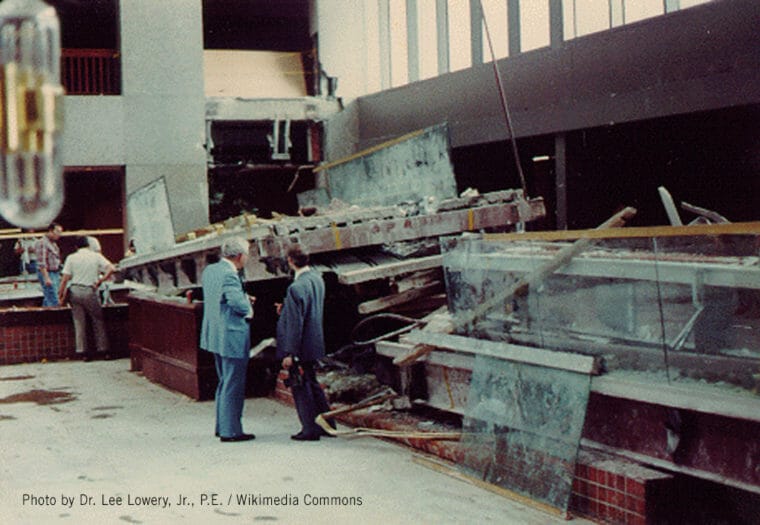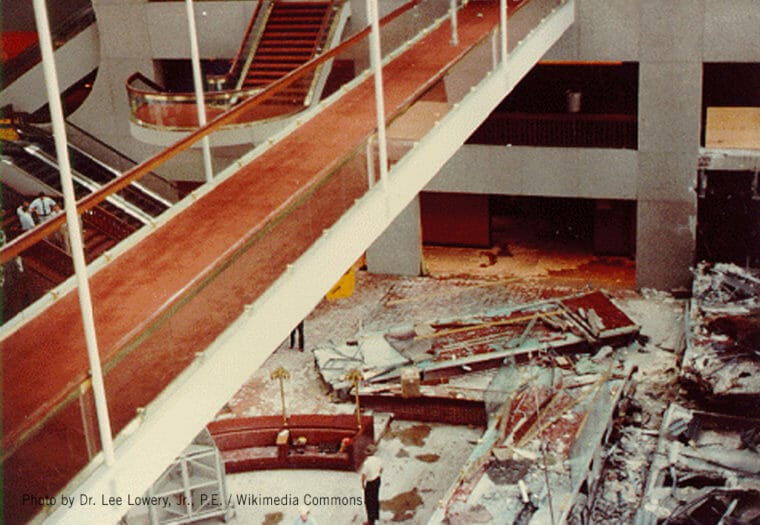Insight | Mar 22, 2018 | Arora
The Accountable Engineer: Reflecting on the Importance of Proper Design Review
As the Florida International University (FIU) bridge collapse tragedy unfolds, and investigators rush to the scene to determine the cause and the responsible parties, it reminds me of another tragic event involving structural failure, which took the lives of over 100 people. The 1981 Kansas City Hyatt Regency Hotel walkway collapse. Known as the deadliest structural collapse in U.S. history (notwithstanding the World Trade Center attacks), the walkway collapse demonstrates how a simple series of missteps could lead to such devastation and how accountability is paramount.
If you are not familiar with the walkway collapse, here is a summary. A stacked walkway suspended from the roof structure spanned the large atrium of the hotel lobby. The walkways were supported by box beams, hung from single tie rods attached to the structural roof. The original design called for each stacked box beam to be supported by tie rods through a mechanical connection, for this case, a washer and nut. Think of a trapeze using parallel vertical threaded rods with horizontal box beams, through holes sitting on a nut and washer connection, a simple design. The fabricator objected to the original design since it required the whole rod to be threaded, and most likely the threads would have been damaged during shipping and construction. The contractor offered an alternative design of providing a two-rod support system. The first rod would support the top box beam, then a second rod connected to the top box beam would hold the lower box beam. The structural engineer approved this change without fully reviewing it.

Original design vs. actual construction
Photo by DTR / Wikimedia Commons
The fatal error doubled the load at the top box beam. The total load was unchanged as seen by the roof structure, however, now because of the implementation of a two-rod system, the top box beam carried the load of both walkways. This connection at the top box beam was the point of the structural failure. The investigation revealed a breakdown in communication between the engineer and the fabricator, leading to a lack of proper design review of the proposed change, along with performing revised calculations.

Fourth floor beam, day one of the investigation
Photo by Dr. Lee Lowery, Jr., P.E. / Wikimedia Commons
As humans we are flawed, errors are inevitable, and combating them is our greatest challenge. But, as engineers we are also responsible for the citizens using our designs and we are held accountable to them. When tragic events such as this happen, words like quality assurance, design review, calculations, submittal review, and change orders take on a meaning beyond the development of construction documents and the pressure of schedules. We must trust our training and experience, and always be diligent in resolving issues first and foremost as to honor our obligation to the public’s trust. The fast time line, the simple and quick response, and the unreasonable demand pushes us to violate our code of ethics and serves no purpose.
As the investigation starts in Florida, the loss of life will be recognized, the fatal cause will be determined, people will be held accountable, and a tragic lesson will be learned.




